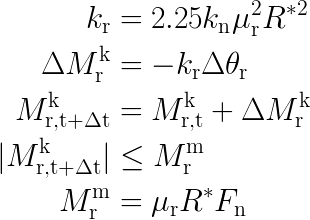
Syntax:
rolling_friction epsd3
Description:
This model can be used as part of pair gran and fix wall/gran
The elastic-plastic spring-dashpot (EPSD) model (see Ai et al.) adds an additional torque contribution, equal to

where the torque due to the spring M_rk is calculated as

Here k_r denotes the rolling stiffness and dtheta_r is the incremental relative rotation between the particles. The spring torque is limited by the full mobilisation torque M_rm that is determined by the normal force F_n and the coefficient of rolling friction (rmu) (compare the CDT model).
The rolling stiffness k_r is computed using the "coeffRollingStiffness" prefactor, that needs to be defined by the user (see below). k_r is computed from k_r = coeffRollingStiffness*k_n*rmu*rmu*reff*reff.
The viscous damping torque M_rd is implemented as

where in the current implementation the damping is disabled in case of full mobilisation (f = 0). The damping coefficient C_r may be expressed as:

Here I_i/j is the moment of inertia and m_i/j is the mass of the particles i and j, respectively.
The coefficient of rolling friction (rmu) must be defined as
fix id all property/global coefficientRollingFriction peratomtypepair n_atomtypes value_11 value_12 .. value_21 value_22 .. .
(value_ij=value for the coefficient of rolling friction between atom type i and j; n_atomtypes is the number of atom types you want to use in your simulation)
This coefficient rmu is equal to the rmu as defined in the CDT model. In addition to rmu, eta_r is the required material property that must be defined as
fix id all property/global coefficientRollingViscousDamping peratomtypepair n_atomtypes value_11 value_12 .. value_21 value_22 .. .
(value_ij=value for the coefficient of rolling friction between atom type i and j; n_atomtypes is the number of atom types you want to use in your simulation)
The "coeffRollingStiffness" prefactor needs to be defined by the user as
fix id all property/global coeffRollingStiffness scalar value
Please see Ai et al., 2011 for discussion.
IMPORTANT NOTE: You have to use atom styles beginning from 1, e.g. 1,2,3,...
(Ai) Jun Ai, Jian-Fei Chen, J. Michael Rotter, Jin Y. Ooi, Powder Technology, 206 (3), p 269-282 (2011).